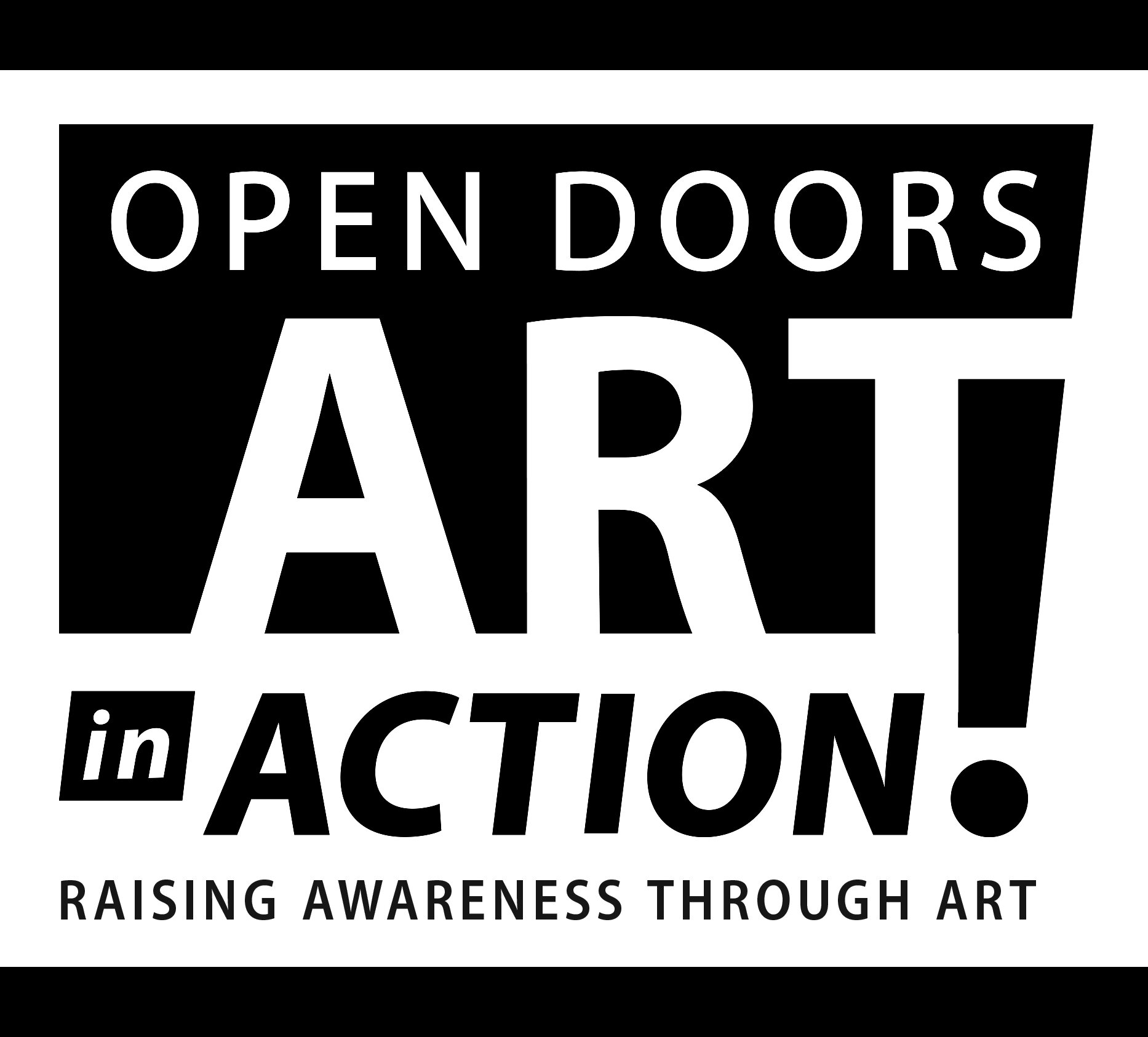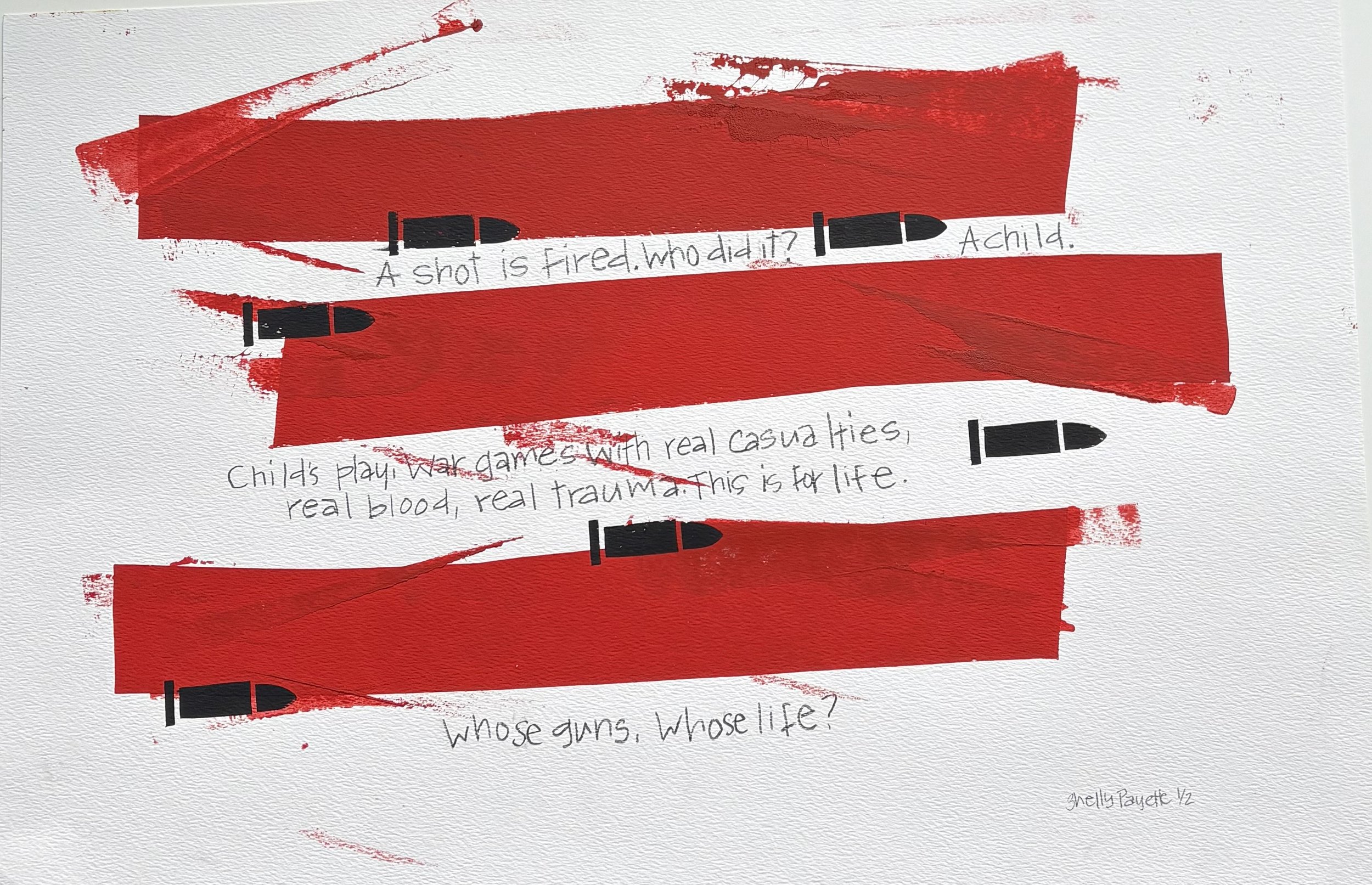ENDING GUN VIOLENCE :
HEALING OUR SOULS
Gun violence threatens our most fundamental right: the right to life. More than 600 people die every day worldwide, by guns. This exhibit attempts to raise awareness about gun violence through national and local artists and two non-profit gun violence prevention organizations: the Soul Box Project and Moms Demand Action for Gun Sense in America.
More than 200,000 hand-made, origami Soul Boxes were made by people across the U.S. who care about this escalating health crisis. Each Box represents a person killed or injured by gunfire.
The Soul Box Project was created by Portland artist Leslie Lee in the wake of the 2017 Las Vegas shooting. She knew people needed to experience the numbers in a visceral way, to really grasp the scale of the gunfire epidemic. As community groups and individuals folded Soul Boxes, the Project gained momentum as a nationwide movement to raise awareness.
Since reaching the goal to exhibit 200,000 Soul Boxes on D.C.’s National Mall in 2021, the Project continues to provide dramatic visual support for all initiatives working to reduce gun violence. Additionally, the process of creating the Boxes offers a calming, restorative activity to people experiencing the effects of trauma.
Exhibits represent and honor people of every race, cultural background, gender identity, sexual orientation, religious or political affiliation—none of whom are immune from this national epidemic.
Moms Demand Action for Gun Sense in America
Moms Demand Action works strategically in a multifaceted approach to address gun violence through federal and state legislative action, partnership engagement, school safety, public education and electoral action. Volunteers develop strategic plans to enact change at all levels with the single mission of preventing gun violence.
Artists in the Exhibit
Shelly Payette, Aleena Hubbard, Sydney Norton, Ezekiel Hodo, Niko Bare & Kari Wehrs
Shelly Payette
I was born in Boston Massachusetts, where my father was an architect with a degree from the Harvard Graduate School of Design. I was heavily influenced by his modernist style. My two older brothers and younger sister are architects, but I chose to study industrial design as part of the Fine Arts program at Syracuse University. I am happiest when I am creating as it helps me work through tough times.
Artist statement: These works come from my family’s experience. It was a beautiful February day in Phoenix and my granddaughters and daughter had come to visit me. I was euphoric as we all walked down my street in the afternoon to get dinner. In an instant, euphoria changed to terror as we entered a gang war zone. 19 shots were fired; my oldest granddaughter fell in front of me screaming with blood coming from her back. We were now fighting for our lives. The shots were fired by 16-year-old kids.
Artist: Shelly Payette
Title: Our Lives Were Changed
Year: 2024
Artist: Shelly Payette
Title: A Shot Is Fired
Year: 2025
Alleena Hubbard
I was born and raised in Arizona. I earned an AAFA in fine art from Estrella Mountain Community College in 2023. My art talks about nature. life and death in our society. I’m still a dedicated student and currently studying towards her new degree in art education at Northern Arizona University.
Artist Statement: I am studying to become an art teacher. In art class, crayons are a common medium for students. The colors I’ve chosen highlight the primary colors taught in art education. Gun violence in schools is an unfortunate reality we live with in this country. This issue, which has tragically become all too frequent, demands attention and awareness. I aim to highlight how gun violence is often so pervasive in society that it risks becoming invisible or normalized. The bullet, almost camouflaged, forces the viewer to pursue and reflect-challenging us not to become desensitized to the tragedy at hand.
Artist: Alleena Hubbard
Title: 1-in-4
Year: 2025
Media: 100% cotton threads on 100% cotton Aida cloth
Method: Cross-stitch embroidery, by hand
Sydney Norton
I grew up in Glendale Arizona and have come to Flagstaff for college. Currently I’m working on my BFA in Ceramics at Northern Arizona University. My current work includes ceramic animal sculptures and vases with sculpted details. I plan on continuing my education and developing my skills in grad school.
Artist Statement: This vase is meant to show the connection between bullets and gun violence using flowers to symbolize the profound loss our society experiences as a result of gun violence. The direct image of a bullet is intended to confront the normalcy of gun violence and to reimagine a destructive object into a vessel that shows the love and community for those who have lost their lives to gun violence.
Artist: Sydney Norton
Title: Bullet Bud Vase
Year: 2025
Media: Ceramic
Ezekiel Hodo
I am a 22-year-old artist from Ames, Iowa. I’m currently a full-time student at NAU, majoring in art education, while also working as a freelance digital artist. My work primarily explores the human condition, expression, and the mind. Throughout my artistic journey, I’ve had the honor of having my work displayed at notable locations, including the Capitol Building in Washington, D.C. In 2023, I also had the privilege of organizing and curating my own exhibition for ArtWalk, where I was able to showcase my own art alongside the works of other talented artists. These experiences have played a key role in my development as both an artist and a curator, fueling my ongoing creative process.
Artist Statement: My work explores the complex and deeply personal realities of gun violence and mental health, with a particular focus on the often-overlooked fact that nearly 60% of gun-related deaths in the U.S. are suicides. While mass shootings, though devastating, make up less than 1% of incidents, they dominate public discourse—leaving the silent suffering of many unaddressed. Through this painting, I aim to capture the emotional precipice—the moment of fear, resignation, or reflection that so many experience when confronted with the weight of their own minds. The composition intertwines memory, paralysis, and the stark contrast between fleeting bliss and overwhelming despair, urging viewers to confront both the fragility and permanence of life. At its core, this piece is not just an expression of my own thoughts but an invitation for others to find their own meaning within it. It challenges the tendency to place blame solely on external forces and instead asks us to examine the deeper societal and personal struggles that drive these tragedies. In an age where disconnection and apathy often overshadow genuine human connection, it is more important than ever to create spaces where people feel safe to be vulnerable. The weight of mental illness and isolation is heavy, but empathy and understanding can serve as a counterbalance. Through this work, I hope to provoke reflection, conversation, and, ultimately, a greater sense of responsibility for the well-being of those around us.
Artist: Ezekiel Hodo
Title: Moribund
Year: 2025
Media: Digital painting on archival paper
Niko Bare
I’m Niko Bare, 21, studying Studio Art and Museum Studies at NAU. Additionally, I am certified in both photography and graphic design, which worm their way into my oil painting. I currently intern at NAU’s Beasley Gallery where I help with installations and curations of our various shows. My art has been exhibited mostly through school exhibitions – salon style as well as a building wide showcase.
Artist statement: I wanted to make a painting that did not directly address the topic at hand nor take a specific side. Rather I wanted to focus on the wide access to guns and its impact upon the everyday family. If we ignore mass shootings, the main reason children die from gun violence is simply having access to weapons and handling them improperly. Proper and secure storage is the main suggestion when asking about gun violence prevention in the home. The question I ask myself every time I see a report of a mass shooting (which is too often) is where they got the gun, especially in the case of school shootings. The answer, unfortunately, is usually from loved ones.
My painting harkens back to the ‘do you know where your children are?’ ads that ran for decades. I wanted something familiar and nostalgic that almost serves to soften a difficult subject. In that dreamy space, I still wanted my message to be crystal clear - hence the geometric shapes and sharp lines. Whether or not we should have access to guns as easily as we do is not the question I am asking. The reality is that we do. So how do we minimize avoidable accidents or even extreme acts of violence?
Kari Wehrs
Kari Wehrs is a photo based artist and educator. She received her MFA in photography from Arizona State University in the spring of 2018. As a child, Kari spent hours flipping through her Grandmother’s family photo albums that dated from the late 1800s to the mid 1900s. The photographs were compiled neatly, often with handwritten notations, which suggested to her that they were precious objects. Wanting to see the details of each image, Kari often examined the photographs with her Grandmother’s magnifying glass. She found the idea that time could be recorded and “held” in photographs to be truly fascinating. Kari is currently the Photography Program Chair at the Maine Media Workshops + College in Rockport, Maine. Prior to this, she had been associated with MMW+C since 2008, and has been a workshops instructor since 2012. Kari has a deep interest in the techniques, technology, and history of the photographic medium. While embracing multiple methods in her own work, her most recent series is portraiture employing the 1850s wet plate collodion process (tintypes).
Shot, 2016-2020
Artist statement: From scenes of gun violence that make the national news, to my 61-year-old mother suddenly deciding to carry, incidents of gun use haunt me with curiosity and fear. Having no personal attachment to guns, I am grappling with present day societal reverberations and implications of the gun in American culture. To create this series, I set up my darkroom tent and tintype gear at known target shooting locations in the Arizona desert. I meet gun enthusiast strangers and ask if they are willing to participate in my project. I create their tintype portraits, and when complete, I give them the option to use the image as target. Some take part – leaving bullet holes in the plate. “Shot” refers simultaneously to my use of the camera and the participant’s use of the gun. Tintypes were the primary form of photography during the American Civil War – another time when the country exhibited vast divides. Soldiers often posed for their tintype in military uniform and with weaponry. My use of this form of photography in contemporary time elaborates on these connections to history. I view this project as a method to investigate and provoke both personal and collective consciousness. How might we need to re-consider this time in our history? When do/didour rights become our burdens? How do we want to think of our social or political opposite, and how might crossing uncomfortable boundaries potentially lead to positive change? How do we freshen the all-too-often predictable “gun debate”, and instead pursue an exchange to reconcile our differences and move beyond our current impasse?
Artist: Kari Wehrs
Title: Aaron
Year: 2019
Artist: Kari Wehrs
Title: Aimee & Mike
Year: 2017

















